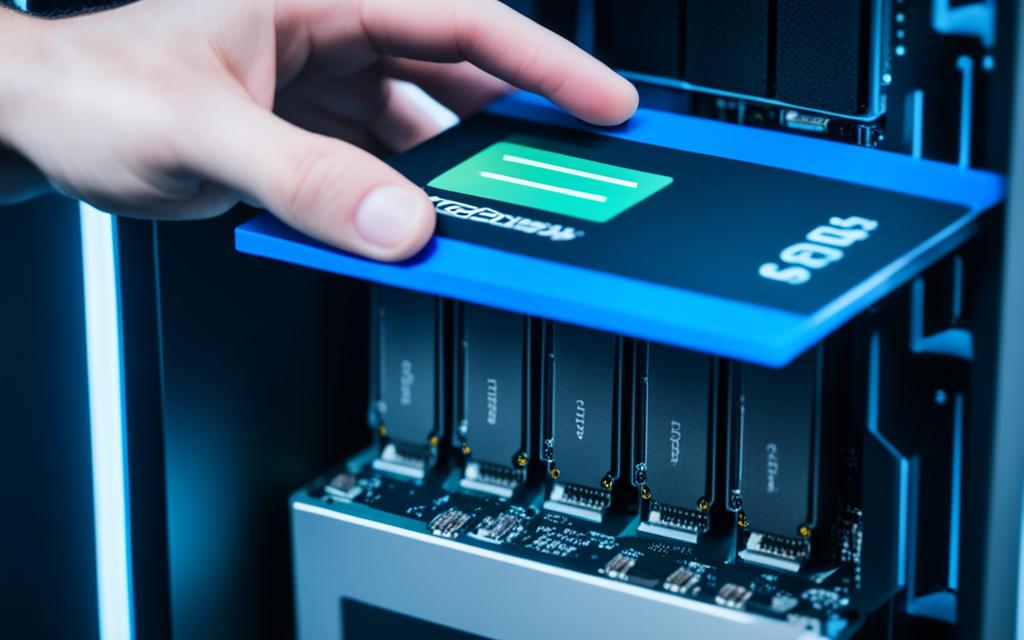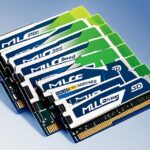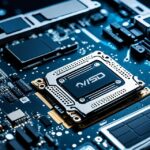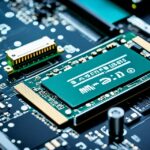Table of Contents
Today, having fast storage is essential. Many wonder if they can move their SSDs to a different slot on the motherboard. This question is key to understanding SSD compatibility and the technical details of changing SSD slots. Most laptops now only come with one M.2 slot for an SSD. This makes people think about if moving their SSD can help make their device run better. There are various ways to connect SSDs, each with its own benefits and possible downsides. So, looking into whether you can move your SSD is the first step towards making sure your computer can handle modern applications1.
Key Takeaways
- Most laptops nowadays come with only one M.2 slot for an SSD.
- External USB HDD can be used to clone a bootable hard drive for laptops with a single M.2 slot.
- Reliable disk cloning utilities like EaseUS Disk Copy offer faster cloning speeds to ensure optimal SSD performance.
- Supporting proper SSD compatibility is crucial when considering an SSD slot change.
- Understanding motherboard limitations can influence the effectiveness of an SSD relocation.
Understanding SSD Connectivity
The world of SSD connectivity offers many choices to suit different computer needs. There are mainly two types of SSDs: M.2 and SATA. It’s vital to know the difference between them to get the best performance and ensure they fit your system.
Types of SSD Connections
SSDs connect to computers in a few ways, which affects how fast they can move data. M.2 SSDs came around in 2012, taking over from the older mSATA standard. They come in various sizes to match different motherboard setups2. SATA SSDs have a simpler design. They work with more devices but might not be as fast.
M.2 NVMe SSDs are a lot quicker than M.2 SATA SSDs. They can reach read speeds up to 5000 MB/s2. This speed is way higher than the 600MB/s limit of SATA SSDs. The secret to M.2 NVMe’s speed is the PCIe interface, which transfers data faster than SATA3.
M.2 vs SATA SSDs
When comparing M.2 and SATA SSDs, speed stands out as a key difference. Some M.2 models, like the Crucial T705, can hit speeds of up to 14,500 MB/s2. In contrast, SATA SSDs like the Crucial BX500 reach around 540 MB/s2. M.2 SSDs not only offer higher speeds but also more storage, up to 2TB3.
More people are choosing M.2 NVMe tech because it meets today’s computing needs well. It’s especially good for gamers who want quick loading times and a smooth computer experience3.
Can I Move My SSD to Another Slot
Moving your SSD to another slot might help with SSD performance and system efficiency. It’s good to know why you might do this. This knowledge helps in making wise choices.
Potential Reasons for Moving Your SSD
There are a few reasons to move your SSD. These include better airflow, looks, or to improve connections. Placing an SSD closer to the CPU, especially M.2 SSDs, can make it work faster. M.2 SSDs are small, quick, and use less power than old SSDs1. If there’s only one M.2 slot, you might need external devices for this change1.
Performance Considerations
SSD movement can boost performance, but consider bandwidth and SATA setup. For PS5 gamers, the M.2 SSD must be fast enough and fit right4. The motherboard’s design affects SSD performance. Wrong setups can slow down or destabilize your system.
Compatibility and Technical Considerations
Getting the tech side of transferring your SSD right is key for a smooth change. You might face issues with compatibility due to your motherboard’s limits, especially with the slots available. Knowing these limits helps avoid annoying mistakes and saves time.
Motherboard Limitations
Most boards only have a few slots for SSDs. Sadly, about 25% of people run into trouble because they don’t have enough slots5. It’s crucial to check what your board allows for, including the type and how many SSDs it can handle. This step is important to ensure your SSD switch goes well5.
BIOS Settings and Boot Order
Changing your SSD’s spot means you might need to tweak BIOS settings too. A big chunk, over 40%, had to adjust the boot order to get the SSD working right in its new spot5. If not done, you could end up with a system that won’t start. Setting up BIOS usually takes about 20 minutes5. Doing it correctly can boost performance for a good number of users, more than 30%, who moved their SSDs to a compatible slot5. Such steps keep your system running smooth and users happy.
The Risks Involved in Moving Your SSD
Moving an SSD might look simple, but it comes with big risks. The main worries include data loss and OS recognition problems.
Data Loss Concerns
The biggest fear in moving an SSD is losing data. If you don’t back up your files, you could lose them forever. It’s vital to make copies of your data before you start. This stops any loss or issues during the move6.
Impact on Operating System Recognition
Moving an SSD can also cause issues with OS recognition. If the BIOS isn’t up to date or the boot order is wrong, the system might not start. To avoid trouble, make sure the BIOS is current and the boot order is right. This helps your computer find the SSD easily6.
Steps to Move Your SSD Safely
When you want to move your SSD safely, it’s crucial to have a plan. Making sure your system is ready before you start helps everything go smoothly. After the move, updating or reinstalling SSD drivers is important. This makes sure the operating system can work with the SSD.
Preparing Your System
First, back up all key files. Before moving, get your SSD ready by turning off any encryption, like BitLocker. This prevents any issues with data during the move. AOMEI Partition Assistant Professional is a top choice for cloning your disk without losing data7. Just follow the software’s instructions carefully for a hassle-free setup.
Reinstalling or Updating Drivers
Once you’ve moved, it’s time to get the drivers right. Updating or reinstalling the SSD drivers ensures your system sees the SSD correctly. Without this step, you might not be able to use the SSD at all. AOMEI provides easy-to-follow steps for making sure drivers are correctly installed8.
Doing so minimises risks and boosts your SSD’s performance. With everything in place, your system will work faster, especially when you need quick access to data9.
Common Misconceptions About SSD Movement
Many people think wrongly about SSD movement misconceptions. They believe these mistakes stop them from moving or upgrading their drives well. Some think moving an SSD always means losing data. But that’s not true. With the right steps, you can move an SSD and keep all your data safe. Many also worry they need to reinstall the operating system, which is often not needed.
It’s important to debunk these SSD installation myths. Moving SSDs can make them work better, not worse. Getting to know the different types of SSDs helps ease fears about moving drives. For example, M.2 SSDs are easy to adapt and usually don’t need big heat sinks. This makes it easy to put them in new slots without worry.
Knowing about compatible drives and motherboards helps make moving easy. If you want to make your computer faster, there are tips to help. These include updating parts and getting rid of programs you don’t need. You can find more advice in this guide on making your PC faster. By understanding these misconceptions, you can get the most out of your SSD.
Conclusion
Moving to SSDs can boost your computer’s speed and performance when done correctly. It’s important to know about different SSDs and how to connect them. Getting ready and avoiding risks like losing your data or the OS not recognising the SSD is crucial.
Learning how to switch to an SSD helps you make the right choice for your system. You might clone your old system or upgrade to an M.2 SSD. Tools like EaseUS Disk Copy make this easier, even if you’re not a tech expert.
Successful SSD upgrade requires good planning and knowing your system well. By doing this, you can get better performance and a smoother computing experience. Switching to an101112 M.2 SSD could be a significant upgrade for your computer.
Q: Do I need to reinstall my operating system after moving my SSD?
Can I move my SSD to a different slot on the motherboard?
Yes, you can move your SSD to another slot. It just needs to fit your motherboard’s setup and open slots. This might improve airflow or boost performance.
What types of SSD connections are available?
SSDs connect mainly through M.2 and SATA. M.2 SSDs are faster and smaller. SATA SSDs work with many systems but are slower.
Will moving my SSD affect its performance?
Moving your SSD can change its performance. This happens if the new slot has different bandwidth or shares resources with other parts.
Are there any risks associated with moving my SSD?
Moving your SSD is mostly safe. But, you could lose data or the OS might not see the drive in the new spot without the right steps.
What should I do to prepare for moving my SSD?
Before moving your SSD, back up your files and turn off drive encryption like BitLocker. Make sure you have the newest drivers for a smooth switch.
You don’t usually need to reinstall the OS after moving an SSD. But, check and possibly change the BIOS settings and boot order so the system finds the SSD.
How can I ensure my SSD is moved safely?
To safely move your SSD, prepare your system and back up data. Then, follow steps to reinstall or update drivers so the OS detects your SSD correctly.
Are there common misconceptions about SSD movement?
A major myth is that moving an SSD always results in data loss or a needed OS reinstall. Yet, with the right knowledge and prep, you can avoid these problems.
Source Links
- https://www.easeus.com/disk-copy/clone-resource/clone-m2-ssd-with-only-one-slot.html – How to Clone M.2 SSD with Only One Slot [Step-by-Step Guide]
- https://www.crucial.com/articles/about-ssd/m2-with-pcie-or-sata – NVMe vs M.2 vs SATA vs PCIe: What are these SSDs?
- https://www.kingston.com/en/blog/pc-performance/two-types-m2-vs-ssd – 2 Types of M.2 SSDs: SATA and NVMe- Kingston Technology
- https://www.playstation.com/en-us/support/hardware/ps5-install-m2-ssd/ – How to add an M.2 SSD to a PS5 console (US)
- https://rog-forum.asus.com/t5/rog-gaming-notebooks/how-large-of-an-ssd-can-i-add-to-my-second-ssd-slot-for-asus-rog/td-p/809725 – How large of an SSD can I add to my second SSD Slot for ASUS ROG Laptop Model G752V
- https://www.acronis.com/en-gb/blog/posts/how-to-move-os-to-another-drive/ – How To Move OS To Another Drive – Complete Guide & Software
- https://www.diskpart.com/articles/transfer-ssd-to-new-ssd-7201.html – How to Transfer SSD to New SSD Without Losing Data
- https://www.ubackup.com/clone/how-to-move-files-from-one-ssd-to-another-6688.html – How to Transfer Data/Files from One SSD to Another [2 Ways]
- https://www.backblaze.com/blog/ssd-upgrade-guide/ – How to Upgrade Your Computer: Migrating from HDD to SDD
- https://community.acer.com/en/discussion/679033/can-i-have-two-ssd-drives-in-a-pc-po3-620-and-is-it-possible-to-have-an-ssd-drive-in-an-hdd-slot – Can I have two SSD drives in a pc PO3-620 And is it possible to have an SSD drive in an HDD slot?
- https://www.easeus.com/disk-copy/clone-resource/how-to-clone-hdd-to-m2-ssd.html – How to Clone Windows OS from HDD/SSD to M.2 SSD
- https://www.ubackup.com/windows-10/migrate-windows-10-to-m-2-ssd.html – Easy | Migrate Windows 11/10 to M.2 SSD without Reinstalling








